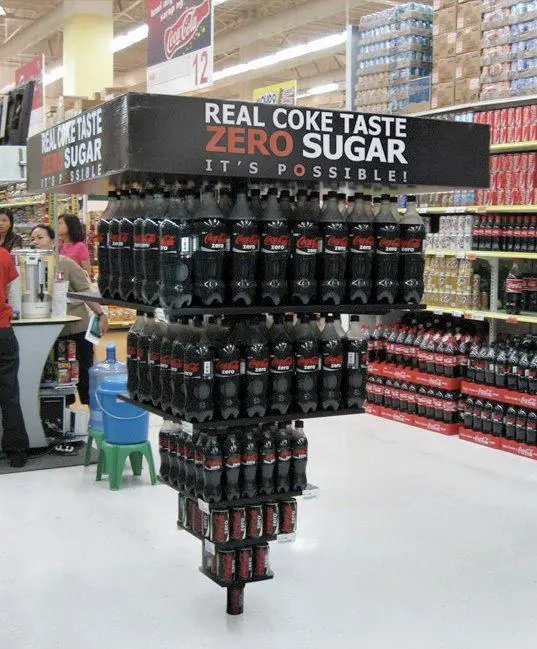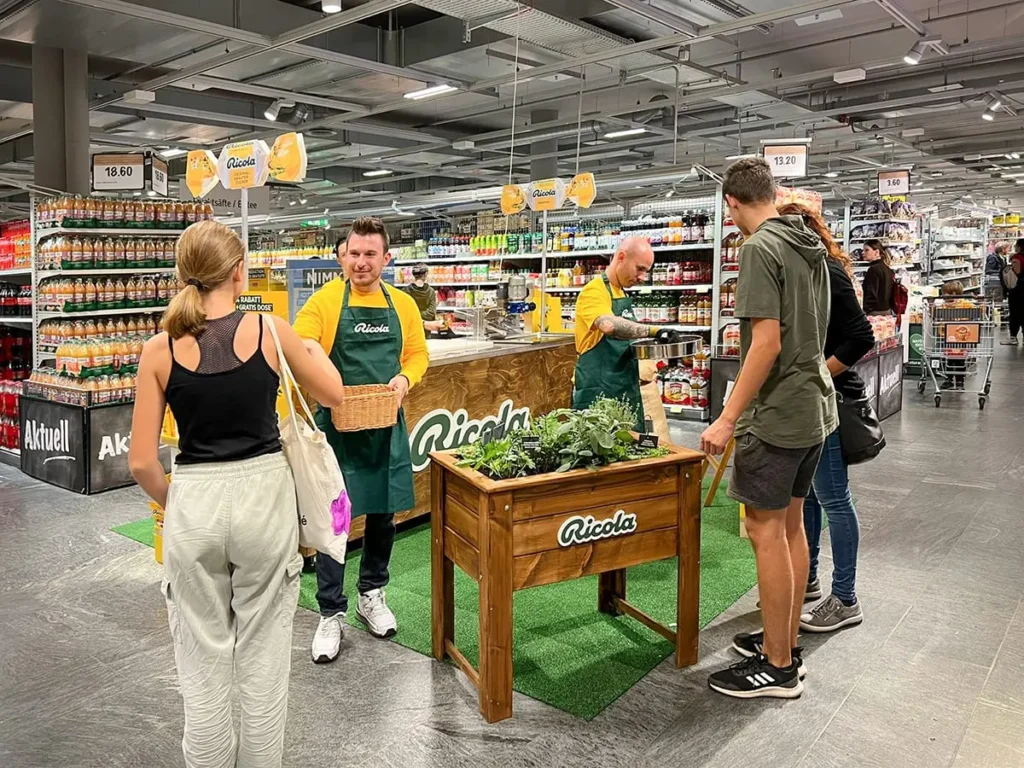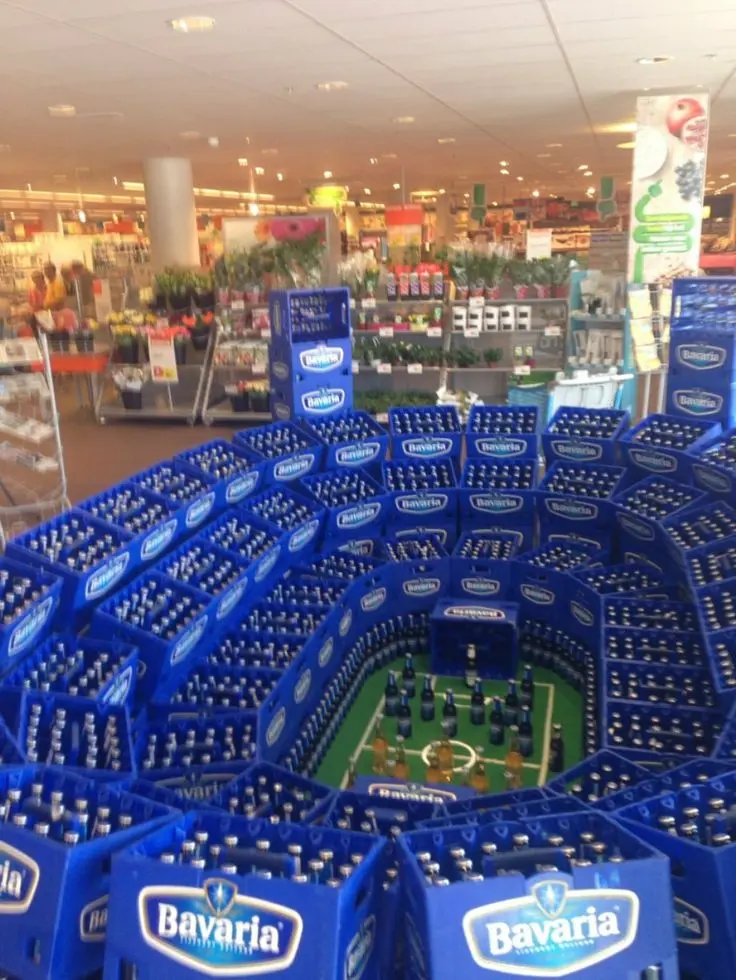How many times have you gone to the store for bread or milk, only to come back with a bunch of other things that caught your eye? If this happens more often than not, you’re in the majority.
In fact, a recent study involving over 3,000 shoppers revealed that 82% of purchase decisions were made in-store. This shows just how valuable in-store advertising can be when it comes to driving sales.
So in this article, I’m going to give you all the steps and inspiration you need to produce irresistible in-store advertising displays. But before that, let’s take a quick look at what in-store advertising is and all the different forms in-store advertisements can take.
What are in-store advertising displays?
In-store advertising covers all the different ways brands can market their products in a physical retail store. The main aim of in-store advertising displays is to grab shoppers’ attention while they’re already in the very place where they can make a purchase.
In-store advertising displays can take lots of different forms, including:
- Stunts – Businesses can create different in-store activations and product displays to catch shoppers’ attention.
- Digital screens – Some grocery stores have TVs or monitors displaying ads and promotional videos near products.
- Product demos – These are live demonstrations of products by store staff or promoters.
- Sampling stations – My fave! Stands and in-store areas where customers can try samples of food, drinks, or other products.
- Window displays – Eye-catching setups in store windows to encourage customers to come inside.
The way you choose to create your in-store advertising display will depend on your budget, business goals, target audience, and more. We’ll come back to this a little later in the article.
Supercharge your marketing reviews
Share, review, and approve all your content in one place with Filestage.
How to create great in-store advertising displays
In-store advertising displays have the power to help you delight customers and boost sales in one swoop. But only if they’re planned and executed properly.
With that said, here are six fail-proof steps to help you create in-store advertising displays that sell.
Step one: Define your goals
Every successful piece of marketing starts by setting clear business objectives. This is what will keep your team focused from that first brainstorm through to final execution.
Of course, creating measurable targets ahead of time will also make it a lot easier to measure the success of your in-store marketing efforts at the end. Which, in-turn, will help you and your team adjust and enhance your approach to move forward. So yeah, you definitely don’t want to rush through this step!
As an example to get the ball rolling, if you’re creating in-store marketing for a potato chip company, you might decide on one or more of these business objectives:
- Boost brand awareness
- Reach a new audience
- Encourage return purchases
- Increase your seasonal sales
- Promote a new range of flavors
Step two: Develop your in-store marketing strategy
Once you know what you want to achieve, it’s time to start building out your in-store advertising strategy. This is the meat and potatoes of your in-store advertising campaign as it’s all about figuring out how exactly you want to promote your business or product.
I’ve broken this step down into a few smaller steps for ease, so take a look below!
Understand your market
First, you’ll want to get a deep understanding of your market. Research what your competitors are doing. Gather data on your target audience’s preferences, shopping habits, and behaviors. Knowledge is key to finding your unique selling point (USP) and creating an effective in-store marketing campaign.
Crunch the numbers
After you’ve done your research, you’ll need to think about budget. The amount of money you have to spend will largely determine what kind of advertising materials you’ll be able to use in and around your in-store display.
Make sure to factor every element of the process into your overall marketing budget. This includes everything from production time and outsourcing to printing, manufacturing, and installation costs.
Think about messaging
What is it you want to say to your audience? What do they need to know about your brand or product? What’s your unique way into their world (and, hopefully, their shopping basket)?
Tone of voice and specific messaging copy will be developed further in the creative process. But at this stage, it’s a good idea to give some direction. This will help your team make sure all advertising materials consistently communicate your USP to reinforce brand recognition and value.
Set out a timeline
Project timelines are important. Without one, you’ll struggle to keep teams on track and in the loop about things like project progress, available resources, and next steps.
To start, decide on the launch date and ensure all materials are in place. Consider seasonal trends and peak shopping times to maximize impact. Then, you can start allocating teammates and contacting any external support you may need.
I know, I know. There’s a lot of things to consider when creating a solid advertising strategy. But just take each step at a time and it’ll be all gravy. Promise!
Step three: Create your in-store advertising displays
Now, all your hard work starts to come together! Because it’s time to create your in-store advertising displays.
When designing your in-store displays, focus on creating visually appealing materials that catch customers’ attention and drive them to take action. Be sure to use high-quality images and graphics that reflect your brand’s identity. And of course, it’s super important to maintain consistency in colors, fonts, and other brand elements.
In terms of messaging, make sure to craft some clear and compelling headlines and a strong call to action (CTA). It’s crucial that your messaging is both informative and instantly gettable.
Sticking to, and playing with, your brand’s tone of voice is key to consistency across your in-store displays and beyond.
Step four: Review your display designs with Filestage
Creating great advertising content is never a one-and-done process. It takes a lot of collaboration and feedback, as well as a few rounds of comments and amends to reach the best results.
It can be easy for teams to get bogged down when reviewing content and tracking progress. So, I’d recommend keeping all your marketing collateral together in one, organized place. And you can do just that with a review and approval platform like Filestage.
Filestage is an approval software designed to make it easier for busy teams to share files, give feedback, and track changes. It works for all kinds of files, including designs, photos, PDFs, HTMLs, and more. That means no matter what kind of advertising content you’re working on, you can trust that Filestage will help get your work out into the world faster.
Here’s how to review your in-store advertising designs in just six simple steps:
- Sign up to Filestage for free
- Create a project and upload files
- Set up reviewer groups and invite reviewers via email or link
- Turn reviewers’ comments into a to-do list
- Upload a new file version and repeat as needed
- Approve the final version with a single click
Step five: Pick the perfect location
The most stunning in-store advertising displays won’t get you the results you want without the right placement. So it’s important to carefully consider the location of your in-store promotions and advertisements.
The locations you choose will depend on your ad materials and business goals. But as a rule of thumb, you want to strategically place your displays in high-traffic areas. This will increase your chances of getting noticed and driving customers to take action.
Once you’ve planned out your locations, you’re ready to start launching your in-store marketing displays.
Step six: Analyze performance
Remember those business goals you set at the start of your marketing process? It’s time to see if your in-store ads have helped you reach these objectives by tracking and measuring performance.
You can gather data from sales reports, customer feedback, and foot traffic counters to get a clear idea of impact. You might also choose to use analytics tools to track interactions with digital ads.
All in all, regularly reporting your findings to stakeholders ensures continuous improvement and better alignment with your marketing goals. So be sure to identify the most effective elements of the campaign and use these insights to refine future strategies.
Five inspiring in-store advertising displays
We’ve covered the key things your business needs to do to create a successful in-store ad campaign. Now, let’s get the creative juices flowing with a look at some stand-out examples of in-store marketing.
Let’s go!
1. Coca-Cola’s gravity-defying product display

Image source: Pinterest
This product display by Coke Zero is a great example of how creativity can help brands stand out from the competition. It’s fresh. It’s playful. And it’s brilliantly on-brand.
As well as creating a memorable customer experience, this in-store advertising display cleverly conveyed the message that it’s possible to enjoy Coke’s great taste with zero sugar.
Of course, an idea like this calls for a lot of consideration and planning. For example, the shelves were made so thin, they almost looked invisible. And staff were instructed to constantly replenish cans to maintain the pyramid’s form and impact. But the effort paid off, with a reported 13% increase in sales.
2. Red Bull’s cardboard car

Image source: The ODM group
Red Bull has been playing in the extreme sport space for some time now. And this creative point of sale (POS) ad replicated Red Bull’s event car for a striking, snap-worthy piece of in-store marketing to support its online marketing campaigns.
By displaying Red Bull’s cans as car engines, the idea brings Red Bull’s products to life in a fun, new way and enhances its audience’s in-store shopping experience. The display ad is also made completely out of cardboard and then constructed in the store for easy transport and lower installation costs.
3. Milka’s in-store sampling station

Image source: EFMP
Milka is a Swiss chocolate brand that’s done some seriously impactful in-store marketing over the years – often revolving around the brand’s iconic purple cow in one way or another.
Every element of Milka’s advertising has been designed to bring people into the brand’s world (the Swiss Alps) and tell a compelling story. And this in-store sampling station does it brilliantly.
The station itself is brought to life through the details, from traditional costumes to the wholesome wooden benches and buckets. By turning product sampling into a memorable customer experience, Milka uses its brand to attract and entertain passers-by.
4. Ricola in-store product demo

Image source: EFMP
This sweet marketing move gave consumers the chance to get a closer look at how Ricola’s candies are cooked and embossed, through an engaging in-store demonstration. The Ricola candy chefs also spoke to shoppers, shared interesting facts about the brand, and handed out the freshly-made products for people to try.
The main aim of this in-store advertising display was to showcase the quality of the raw ingredients used and their careful production process. It took place right at the point of sale, to entice customers to pick up a pack or two.
If creating memorable customer experiences is a key objective, bringing your products to life in-store is a great way to go!
5. Bavaria in-store stadium display

Image source: Pinterest
Beer and sports go hand-in-hand. And this simple, low budget, in-store stunt by Bavaria brings the two together brilliantly.
By understanding its target audience and coming up with a timely and entertaining idea, Bavaria created an unmissable advertising display. Better yet, it’s mostly made using the product itself for maximum impact without needing to spend a bomb on production and installation. Win win!
Depending on what you’re trying to sell, it’s definitely worth exploring what you can do with your products. This is a simple approach that relies on creativity above everything else, so have fun with it.
Final thoughts
In-store advertising displays are a great way to reach customers where they’re most likely to buy. So by creating striking ads in brick-and-mortar stores, you can increase sales and take your business from strength-to-strength. I hope this article helps you create bold, effective work that boosts customer loyalty. And if you’d like to see how Filestage can help you review your in-store advertising ideas and designs, start your free trial today.







